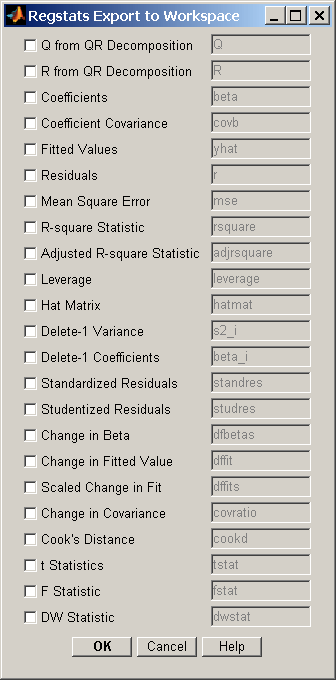regstats
Diagnóstico de regresiones
Sintaxis
regstats(y,X,model)
stats = regstats(...)
stats = regstats(y,X,model,whichstats)
Descripción
regstats(y,X, realiza una regresión multilineal de las respuestas de model)y en los predictores de X. X es una matriz de n por p de p predictores en cada una de las n observaciones. y es un vector de n por 1 de las respuestas observadas.
Nota
De forma predeterminada, regstats añade una primera columna de unos a X, correspondiente a un término constante del modelo. No introduzca una columna de unos directamente en X.
La entrada opcional model controla el modelo de regresión. De forma predeterminada, regstats utiliza un modelo aditivo lineal con un término constante. model puede ser cualquiera de los siguientes:
'linear': términos constantes y lineales (valor predeterminado)'interaction': términos constantes, lineales y de interacción'quadratic': términos constantes, lineales, de interacción y cuadrados'purequadratic': términos constantes, lineales y cuadrados
Alternativamente, model puede ser una matriz de términos del modelo aceptados por la función x2fx. Para obtener una descripción de esta matriz y del orden en que aparecen los términos, consulte x2fx. Puede utilizar esta matriz para especificar otros modelos, incluidos los que no tienen un término constante.
Con esta sintaxis, la función muestra una interfaz gráfica de usuario con una lista de estadísticas de diagnóstico, como se muestra en la siguiente figura.

Cuando selecciona las casillas correspondientes a las estadísticas que desea calcular y hace clic en OK, regstats devuelve las estadísticas seleccionadas al área de trabajo de MATLAB®. Los nombres de las variables del área de trabajo aparecen en la parte derecha de la interfaz. Puede cambiar el nombre de la variable del área de trabajo por cualquier nombre de variable de MATLAB válido.
stats = regstats(...) crea la estructura stats, cuyos campos contienen todos las estadísticas de diagnóstico de la regresión. Esta sintaxis no abre la interfaz gráfica. Los campos de stats se enumeran en la siguiente tabla.
| Campo | Descripción |
|---|---|
Q | Q de la descomposición QR de la matriz de diseño |
R | R de la descomposición QR de la matriz de diseño |
beta | Coeficientes de regresión |
covb | Covarianza de los coeficientes de regresión |
yhat | Valores ajustados de los datos de respuesta |
r | Valores residuales |
mse | Error cuadrático medio |
rsquare | Estadística de R2 |
adjrsquare | Estadística de R2 ajustada |
leverage | Influencia |
hatmat | Matriz de proyección (sombrero) |
s2_i | Varianza de eliminar 1 |
beta_i | Coeficientes de eliminar 1 |
standres | Valores residuales estandarizados |
studres | Valores residuales studentizados |
dfbetas | Cambio escalado de los coeficientes de regresión |
dffit | Cambio de los valores ajustados |
dffits | Cambio escalado de los valores ajustados |
covratio | Cambio de la covarianza |
cookd | Distancia de Cook |
tstat | Estadísticas t y valores de p para los coeficientes |
fstat | Estadística F y valores de p |
dwstat | Estadística de Durbin-Watson y valor de p |
Tenga en cuenta que los nombres de los campos de stats corresponden a los nombres de las variables devueltas al área de trabajo de MATLAB cuando utiliza la interfaz gráfica. Por ejemplo, stats.beta corresponde a la variable beta que se devuelve cuando selecciona Coefficients en la interfaz gráfica y hace clic en OK.
stats = regstats(y,X, devuelve solo las estadísticas que especifique en model,whichstats)whichstats. whichstats puede ser un único vector de caracteres como 'leverage', un arreglo de cadenas como ["leverage","standres","studres"] o un arreglo de celdas de vectores de caracteres como {'leverage','standres','studres'}. Establezca whichstats en 'all' para devolver todas las estadísticas.
Nota
La estadística F se calcula suponiendo que el modelo contiene un término constante. No es correcta en los modelos sin una constante. La estadística de R2 puede ser negativa en los modelos sin una constante, lo que indica que el modelo no es adecuado para los datos.
Ejemplos
Abra la interfaz gráfica regstats utilizando datos de hald.mat:
load hald regstats(heat,ingredients,'linear');
Seleccione Fitted Values y Residuals en la interfaz gráfica:

Haga clic en OK para exportar los valores ajustados y los valores residuales al área de trabajo de MATLAB en variables denominadas yhat y r, respectivamente.
Puede crear las mismas variables utilizando la salida stats, sin abrir la interfaz gráfica:
whichstats = {'yhat','r'};
stats = regstats(heat,ingredients,'linear',whichstats);
yhat = stats.yhat;
r = stats.r;
Sugerencias
regstatstrata los valoresNaNdeXoycomo valores faltantes.regstatsomite las observaciones con valores faltantes del ajuste de regresión.
Referencias
[1] Belsley, D. A., E. Kuh, and R. E. Welsch. Regression Diagnostics. Hoboken, NJ: John Wiley & Sons, Inc., 1980.
[2] Chatterjee, S., and A. S. Hadi. “Influential Observations, High Leverage Points, and Outliers in Linear Regression.” Statistical Science. Vol. 1, 1986, pp. 379–416.
[3] Cook, R. D., and S. Weisberg. Residuals and Influence in Regression. New York: Chapman & Hall/CRC Press, 1983.
[4] Goodall, C. R. “Computation Using the QR Decomposition.” Handbook in Statistics. Vol. 9, Amsterdam: Elsevier/North-Holland, 1993.
Historial de versiones
Introducido antes de R2006a